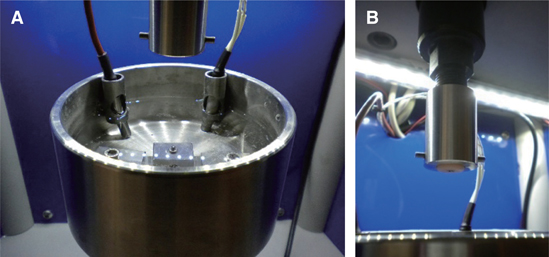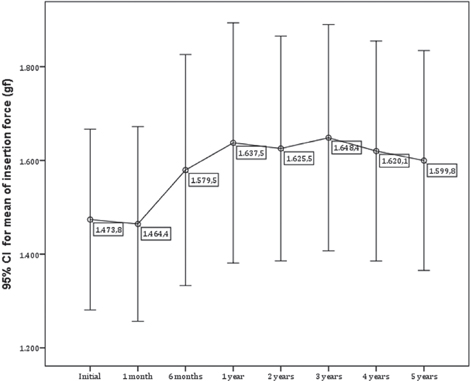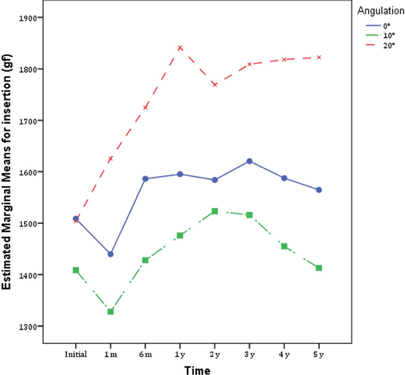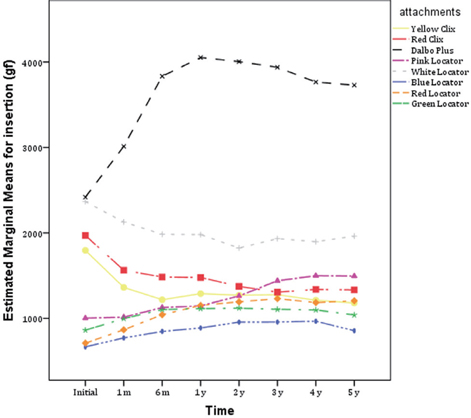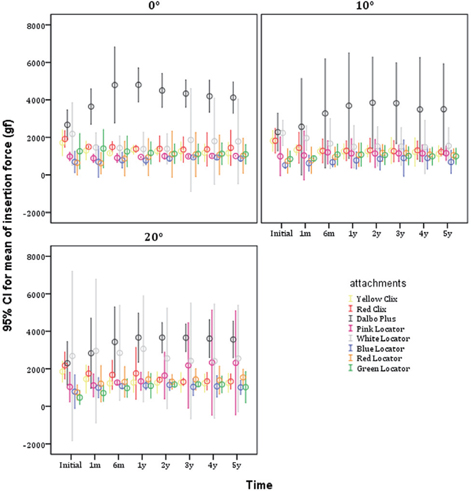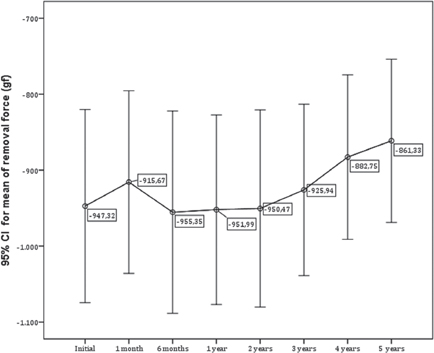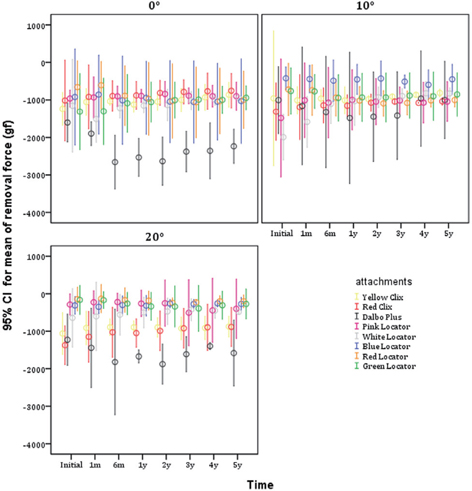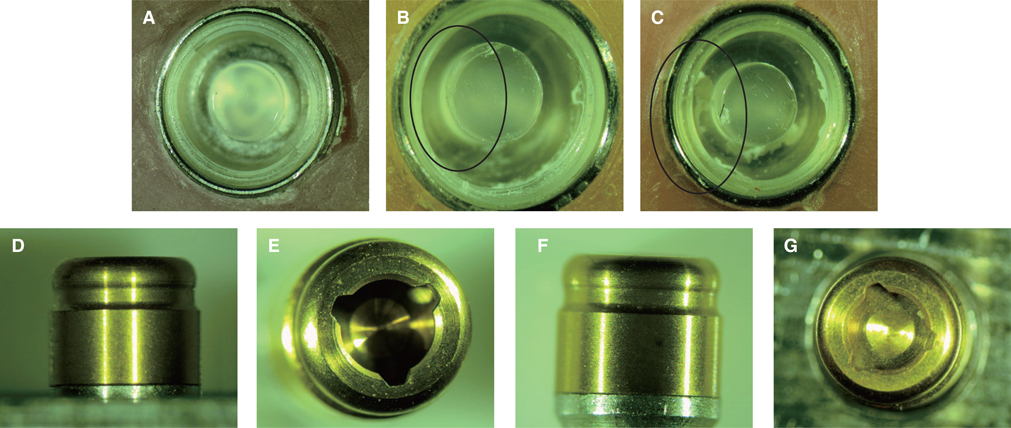J Adv Prosthodont.
2016 Feb;8(1):21-29. 10.4047/jap.2016.8.1.21.
Effect of abutment angulation in the retention and durability of three overdenture attachment systems: An in vitro study
- Affiliations
-
- 1Department of Oral Rehabilitation, Instituto Universitario de Ciencias da Saude (IUCS), Portugal. drcarlosaroso@gmail.com, carlos.ribeiro@iscsn.cespu.pt
- 2Industrial Engineer, Chairman of Idearum, Enginyeria i Innovacio de Producte, Igualada, Barcelona, Spain.
- 3Department of Production and Systems Engineering, University of Minho (UM), Braga, Portugal.
- 4Department of Endodontics, Faculty of Odontology, University of Barcelona, Barcelona, Spain.
- 5Department of Rehabilitation and Maxillofacial Prostheses, Faculty of Odontology, University of Barcelona, Barcelona, Spain.
- KMID: 2393192
- DOI: http://doi.org/10.4047/jap.2016.8.1.21
Abstract
- PURPOSE
This in vitro study investigated and compared the durability and retention of three types of attachments.
MATERIALS AND METHODS
Three commercially available attachments were investigated: Clix(R), Dalbo-Plus(R) and Locator(R). In total, 72 samples of these attachments were placed in the acrylic resin forms and subjected to mechanical testing (5400 cycles of insertion and removal) over the respective ball or Locator abutments immersed in artificial saliva at pH 7 and 37degrees C. The abutments were placed at angulations of 0degrees, 10degrees and 20degrees. The retention force was recorded at the beginning and after 540, 1080, 2160, 3240, 4320 and 5400 insertion-removal cycles.
RESULTS
The results revealed that there were significant differences in the average values of the insertion/removal force due to angulation (F (2.48) = 343619, P<.05) and the type of attachment (F (7.48) = 23.220, P<.05).
CONCLUSION
Greater angulation of the abutments was found to influence the retention capacity of the attachments, and the fatigue test simulating 5 years of denture insertion and removal did not produce wear in the metal abutments.
MeSH Terms
Figure
Reference
-
1. Feine JS, Carlsson GE, Awad MA, Chehade A, Duncan WJ, Gizani S, Head T, Lund JP, MacEntee M, Mericske-Stern R, Mojon P, Morais J, Naert I, Payne AG, Penrod J, Stoker GT, Tawse-Smith A, Taylor TD, Thomason JM, Thomson WM, Wismeijer D. The McGill consensus statement on overdentures. Mandibular two-implant overdentures as first choice standard of care for edentulous patients. Montreal, Quebec, May 24-25, 2002. Int J Oral Maxillofac Implants. 2002; 17:601–602.2. British Society for the Study of Prosthetic Dentistry. The York consensus statement on implant-supported overdentures. Eur J Prosthodont Restor Dent. 2009; 17:164–165.3. Tallgren A. The continuing reduction of the residual alveolar ridges in complete denture wearers: a mixed-longitudinal study covering 25 years. 1972. J Prosthet Dent. 2003; 89:427–435.4. de Jong MH, Wright PS, Meijer HJ, Tymstra N. Posterior mandibular residual ridge resorption in patients with overdentures supported by two or four endosseous implants in a 10-year prospective comparative study. Int J Oral Maxillofac Implants. 2010; 25:1168–1174.5. Kobayashi M, Srinivasan M, Ammann P, Perriard J, Ohkubo C, Müller F, Belser UC, Schimmel M. Effects of in vitro cyclic dislodging on retentive force and removal torque of three overdenture attachment systems. Clin Oral Implants Res. 2014; 25:426–434.6. Tabatabaian F, Saboury A, Sobhani ZS, Petropoulos VC. The effect of inter-implant distance on retention and resistance to dislodging forces for mandibular implant-tissue-supported overdentures. J Dent (Tehran). 2014; 11:506–515.7. Silva AS, Aroso C, Ustrell R, Braga AC, Mendes JM, Escuin T. The influence of saliva pH value on the retention and durability of bar-clip attachments. J Adv Prosthodont. 2015; 7:32–38.8. Faul F, Erdfelder E, Lang AG, Buchner A. G*Power 3: a flexible statistical power analysis program for the social, behavioral, and biomedical sciences. Behav Res Methods. 2007; 39:175–191.9. Branchi R, Vangi D, Virga A, Guertin G, Fazi G. Resistance to wear of four matrices with ball attachments for implant overdentures: a fatigue study. J Prosthodont. 2010; 19:614–619.10. Botega DM, Mesquita MF, Henriques GE, Vaz LG. Retention force and fatigue strength of overdenture attachment systems. J Oral Rehabil. 2004; 31:884–889.11. Queiroz GM, Silva LF, Ferreira JT, Gomes JA, Sathler L. Electrochemical behavior and pH stability of artificial salivas for corrosion tests. Braz Oral Res. 2007; 21:209–215.12. Stüttgen U. Effect of saliva smears in experimental wear studies on precious and non-precious metal casting alloys. Zahntechnik (Zur). 1985; 43:466–468. 470–471.13. Caldwell RC. Adhesion of foods to teeth. J Dent Res. 1962; 41:821–832.14. Setz I, Lee SH, Engel E. Retention of prefabricated attachments for implant stabilized overdentures in the edentulous mandible: an in vitro study. J Prosthet Dent. 1998; 80:323–329.15. Walmsley AD. Magnetic retention in prosthetic dentistry. Dent Update. 2002; 29:428–433.16. Walmsley AD, Frame JW. Implant supported overdentures-the Birmingham experience. J Dent. 1997; 25:S43–S47.17. Cohen BI, Pagnillo M, Condos S, Deutsch AS. Comparative study of two precision overdenture attachment designs. J Prosthet Dent. 1996; 76:145–152.18. Trakas T, Michalakis K, Kang K, Hirayama H. Attachment systems for implant retained overdentures: a literature review. Implant Dent. 2006; 15:24–34.19. Ortegón SM, Thompson GA, Agar JR, Taylor TD, Perdikis D. Retention forces of spherical attachments as a function of implant and matrix angulation in mandibular overdentures: an in vitro study. J Prosthet Dent. 2009; 101:231–238.20. Bayer S, Steinheuser D, Grüner M, Keilig L, Enkling N, Stark H, Mues S. Comparative study of four retentive anchor systems for implant supported overdentures-retention force changes. Gerodontology. 2009; 26:268–272.21. Fakhry A, Tan SC, Heiner AD, Dehkordi-Vakil FH, Dircks HW. Methodology for measuring the in vitro seating and unseating forces of prefabricated attachment systems used to retain implant overdentures. J Prosthodont. 2010; 19:87–94.22. Rutkunas V, Mizutani H, Takahashi H, Iwasaki N. Wear simulation effects on overdenture stud attachments. Dent Mater J. 2011; 30:845–853.23. Chen IC, Brudvik JS, Mancl LA, Rubenstein JE, Chitswe K, Raigrodski AJ. Freedom of rotation of selected overdenture attachments: an in vitro study. J Prosthet Dent. 2011; 106:78–86.24. Al-Ghafli SA, Michalakis KX, Hirayama H, Kang K. The in vitro effect of different implant angulations and cyclic dislodgement on the retentive properties of an overdenture attachment system. J Prosthet Dent. 2009; 102:140–147.25. Kleis WK, Kämmerer PW, Hartmann S, Al-Nawas B, Wagner W. A comparison of three different attachment systems for mandibular two-implant overdentures: one-year report. Clin Implant Dent Relat Res. 2010; 12:209–218.26. Alsabeeha N, Atieh M, Swain MV, Payne AG. Attachment systems for mandibular single-implant overdentures: an in vitro retention force investigation on different designs. Int J Prosthodont. 2010; 23:160–166.27. Lehmann KM, Arnim FV. Studies on the retention capability of push-button attachments. SSO Schweiz Monatsschr Zahnheilkd. 1976; 86:521–530.28. Petropoulos VC, Mante FK. Comparison of retention and strain energies of stud attachments for implant overdentures. J Prosthodont. 2011; 20:286–293.29. Petropoulos VC, Rashedi B. Current concepts and techniques in complete denture final impression procedures. J Prosthodont. 2003; 12:280–287.30. Petropoulos VC, Smith W. Maximum dislodging forces of implant overdenture stud attachments. Int J Oral Maxillofac Implants. 2002; 17:526–535.31. Petropoulos VC, Smith W, Kousvelari E. Comparison of retention and release periods for implant overdenture attachments. Int J Oral Maxillofac Implants. 1997; 12:176–185.32. Uludag B, Polat S, Sahin V, Çomut AA. Effects of implant angulations and attachment configurations on the retentive forces of locator attachment-retained overdentures. Int J Oral Maxillofac Implants. 2014; 29:1053–1057.33. Türk PE, Geckili O, Türk Y, Günay V, Bilgin T. In vitro comparison of the retentive properties of ball and locator attachments for implant overdentures. Int J Oral Maxillofac Implants. 2014; 29:1106–1113.
- Full Text Links
- Actions
-
Cited
- CITED
-
- Close
- Share
- Similar articles
-
- Effects Of Overdenture Retention On The Axial Load Of Implant In The Mandibular Implant-Supported Overdenture
- Mandibular implant-natural tooth retained overdenture using magnetic attachment with stress breaker
- Implant overdenture treatment using several solitary attachment systems on mandibular edentulous patients
- Mandibular implant overdenture using milled bar attachment on implants with unfavorable fixture angulation: A case report
- The influence of the number and the type of magnetic attachment on the retention of mandibular mini implant overdenture


